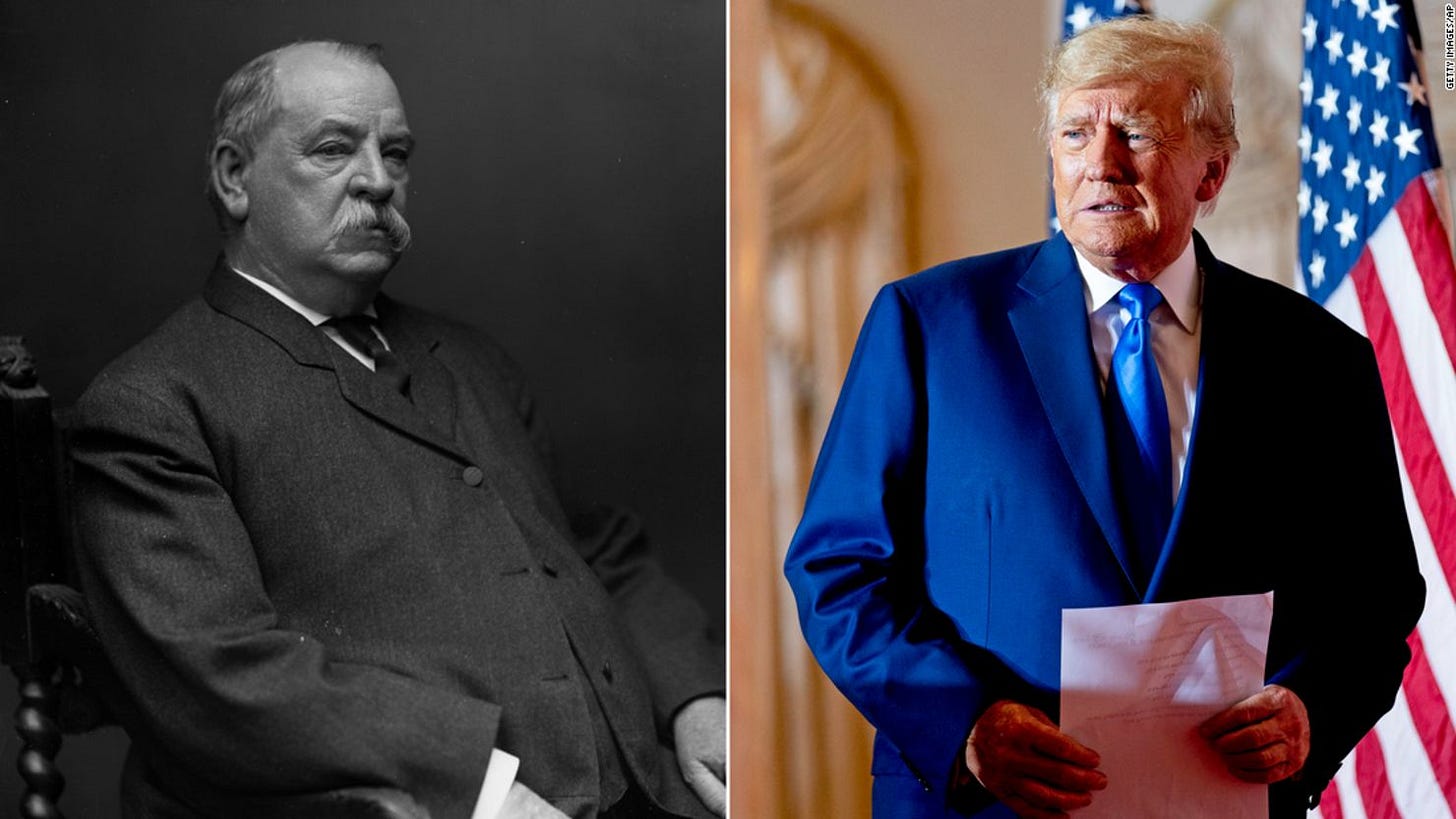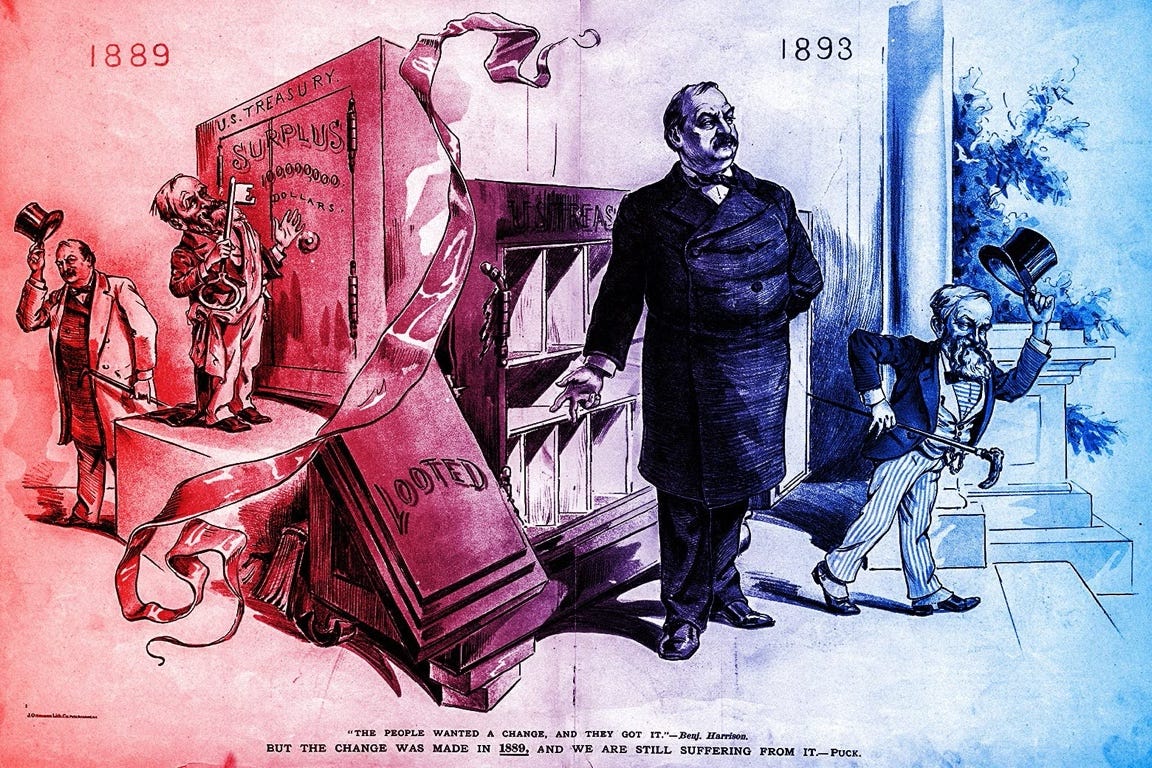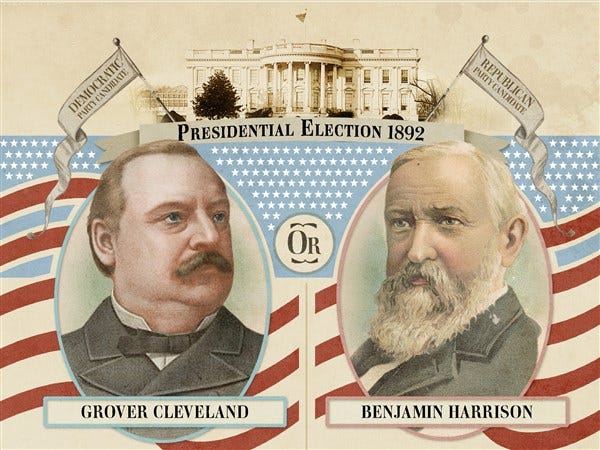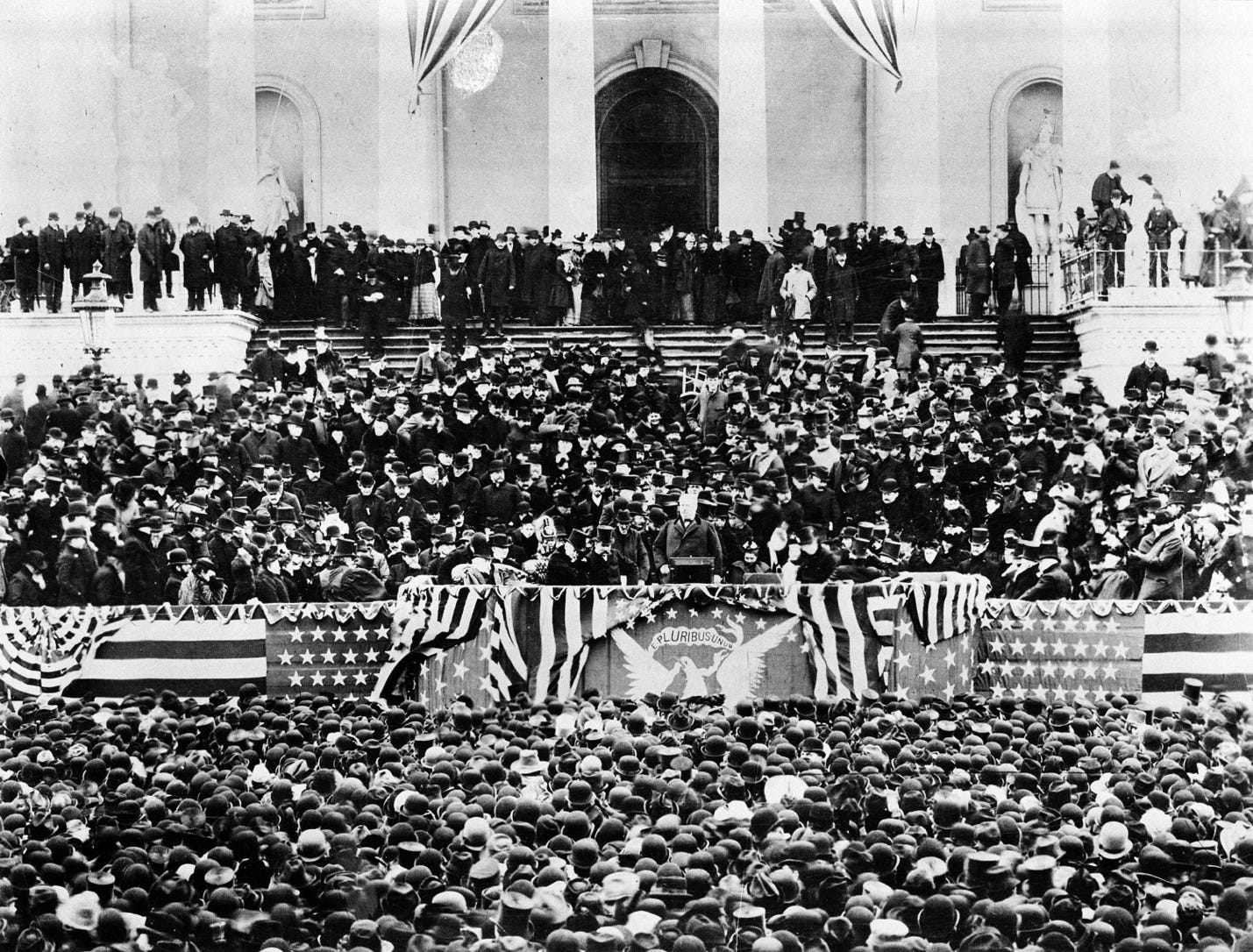In Trump's Re-Election, History Rhymes
The 1892 U.S. Presidential Election and the Parallels with Today
The 1892 U.S. presidential election remains one of the most fascinating chapters in American political history, primarily because it marked the first instance where a president, Grover Cleveland, won a second, non-consecutive term after losing a reelection bid. Cleveland’s triumph over incumbent President Benjamin Harrison symbolized the shifting currents of voter sentiment in the Gilded Age and reflected deep concerns over economic policy and government accountability.
The election provides an insightful lens for examining today’s politics, particularly the dynamics between Donald Trump and Joe Biden. The most obvious reason is the 1892 election is the only precedent for what Trump was able to achieve by being elected to his own second, non-consecutive term. Another is that the economic issues now central to our political debates, such as tariffs, were very much central to the same debates over a century ago.
Grover Cleveland: Reform-Minded Leader
Grover Cleveland rose to prominence as a politician with a reputation for honesty and integrity. Born in 1837 in Caldwell, New Jersey, he practiced law in Buffalo, New York, before entering public service. As mayor of Buffalo and later governor of New York, Cleveland championed reformist policies, gaining a reputation for fighting political corruption and machine politics.
In his time as New York Governor, he openly defied the Tammany Hall political machine and relied on the support of a faction of anti-corruption Republicans, later known as “Mugwumps”, and an alliance of convenience with New York State Assembly minority leader Theodore Roosevelt to pass his policies. He became known as the leader of the “Bourbon Democrats”, who opposed high tariffs, silver-based currency (as opposed to gold), imperialism, and subsidies.
In 1884, Cleveland’s clean image propelled him to the presidency, making him the first Democrat to hold the office since the Civil War. His term was marked by battles over spending, civil service reform, and his use of the veto power. Cleveland’s opposition to pensions for Civil War veterans and his support for the gold standard alienated key constituencies, particularly veterans and farmers. Cleveland’s presidency also coincided with industrialization and the rise of powerful business interests. In the 1888 election, his support for tariff reduction became a key issue, setting the stage for a fierce contest with Benjamin Harrison.
Benjamin Harrison: The Republican Standard-Bearer
Benjamin Harrison, born in 1833 in North Bend, Ohio, was the grandson of President William Henry Harrison. A Civil War veteran and a lawyer, Harrison’s reserved demeanor and deep knowledge of policy made him a respected figure in the Republican Party. He served as a U.S. senator from Indiana before being nominated for president in 1888. Harrison’s campaign in 1888 focused on protective tariffs, a cornerstone of Republican economic policy at the time. Tariffs were seen to protect American industries from foreign competition, a stance that resonated with manufacturers and industrialists.
The 1888 election was a pivotal moment in American politics. Cleveland sought reelection on a platform of tariff reform, arguing that high tariffs benefited wealthy industrialists at the expense of ordinary Americans. Harrison defended the protective tariff as essential for economic growth and national prosperity. Although Cleveland won the popular vote, Harrison’s strategic victories in key states, such as Midwestern states like Pennsylvania, secured his Electoral College triumph. The result highlighted the sectional divide in American politics. Cleveland’s support was concentrated in the South, a Democratic stronghold, and parts of the North, while Harrison dominated in the industrial Midwest and Northeast.
As president, Harrison signed the McKinley Tariff of 1890 into law, which raised import duties to unprecedented levels. While the tariff pleased industrialists, it led to higher consumer prices and widespread public dissatisfaction. Harrison also oversaw the passage of the Sherman Antitrust Act, aimed at curbing monopolistic practices, and supported measures to expand pensions for Civil War veterans. Despite these accomplishments, his administration was criticized for excessive spending, earning the nickname “The Billion-Dollar Congress.”
Cleveland’s loss in 1888 did not diminish his standing within the Democratic Party. His principled stance on economic issues and his reputation for integrity kept him in the public eye, setting the stage for his political comeback in 1892.
The 1892 Election
By 1892, Cleveland remained a popular figure among Democrats, particularly for his opposition to corruption and his fiscal conservatism. At the Democratic National Convention, he easily secured the nomination, with Adlai E. Stevenson of Illinois, grandfather of future Democratic presidential nominee Adlai Stevenson II, chosen as the running mate to balance the ticket geographically. Cleveland’s campaign resonated with voters who were weary of rising prices and government inefficiency. The Democratic Party also benefited from the emergence of the Populist Party, which siphoned votes away from the Republicans, particularly in the West.
Harrison, meanwhile, faced a divided Republican Party. Farmers in the Midwest were disillusioned by the high tariffs, which they blamed for the rising costs of goods. Only large companies could afford the production expansions necessary to take advantage of the protection from foreign competitors provided by tariffs. Smaller firms and workers only experienced price increases. The resulting unrest was exemplified by the Homestead Strike of 1892 by Pennsylvania steelworkers. Finally, Harrison’s personal aloofness and strained relationships with key party operatives weakened his campaign.
Economic issues dominated the campaign, with tariff policy at the forefront. Cleveland’s campaign emphasized the need for lower tariffs to reduce consumer costs, framing the protective tariff as a tool of special interests. Harrison defended the tariff but struggled to overcome widespread dissatisfaction with his administration’s economic policies. The election was a referendum on the economic policies of the Gilded Age. Cleveland won a decisive victory, winning the popular vote and capturing 277 electoral votes to Harrison’s 145. The Democrats also gained control of Congress.
Aftermath of the Election
Cleveland’s second term (1893–1897) was dominated by economic crisis. The Panic of 1893, one of the worst financial crises in U.S. history, triggered a severe depression. Unemployment soared, banks failed, and businesses collapsed. Cleveland’s commitment to the gold standard alienated pro-silver factions within his party and those who wanted to mitigate the resulting depression.
Cleveland’s handling of the Pullman Strike in 1894 further eroded his popularity. His decision to deploy federal troops to suppress the strike angered labor unions and progressives, while his refusal to adopt inflationary policies alienated populists. By the end of his term, Cleveland was deeply unpopular and chose not to run for a third, which would have been allowed before the passage of the 22nd Amendment in 1947, which created the two-term limit for presidents.
After his defeat in 1892, Harrison retired to private life. He returned to practicing law and remained an influential voice within the Republican Party. Harrison’s later years were marked by public speaking engagements and his involvement in international arbitration cases. He passed away in 1901, leaving behind a legacy as a principled leader who supported voting rights for African Americans in the South but a politically constrained leader who enabled political corruption within his party.
Modern Parallels: Trump vs. Biden
The political rivalry between Donald Trump and Joe Biden echoes the dynamic between Cleveland and Harrison in several striking ways. Like Trump, Cleveland spent most of his life in the private sector and quickly rose to the pinnacle of American politics. Harrison similarly was not a career politician, but like Biden, ended up as a placeholder president book-ended by his political rival.
1. Non-Consecutive Terms
Like Cleveland, Trump won a non-consecutive term after losing reelection. Both men remain polarizing figures within their parties, commanding loyalty from their base while facing significant opposition from rivals. They made their name in politics as symbols of rebellion against established political interests, and their charisma allowed them to resist political oblivion after their losses.
2. Economic Focus
The Cleveland-Harrison contests revolved around tariffs and economic policy, much like today’s debates on inflation, trade, and job creation. Trump, like Cleveland, presents himself as a disruptor challenging entrenched interests, while Biden, like Harrison, positioned himself as a steady hand guiding the nation through economic recovery, a position taken up by VP Kamala Harris after Biden dropped out.
3. Party Divisions
Both Cleveland and Trump faced internal divisions within their parties. Cleveland’s commitment to the gold standard alienated populists, just as Trump’s influence over the GOP has sparked tensions between establishment Republicans and his supporters. For now, the internal divisions in Trump’s party have been decisively resolved. Similarly, Harrison and Biden struggled to maintain unity among diverse factions within their coalitions and failed to provide strong leadership, in Biden’s case due to age and in Harrison’s case due to personality.
5. Electoral Dynamics
Both the 1892 and 2024 elections reflect the cyclical nature of American politics, with voters oscillating between calls for reform and desires for continuity. Cleveland’s comeback after a single term mirrors Trump’s potential path, exploiting his opponent’s weaknesses relentlessly while seemingly doing battle with entrenched interests. Harrison’s loss shows the challenges incumbents face during times of economic uncertainty when voters typically demand change and the need for presidents to exhibit strong public leadership.
Conclusion
The 1892 election offers valuable insights into the complexities of American democracy and the enduring themes of economic policy, party divisions, and the power of voter sentiment. As the United States navigates an even more contentious political era, the parallels between Cleveland and Harrison’s rivalry and Trump and Biden’s remind us that history often rhymes.






